Digital Media & Communications: IKEA Global Marketing Plan
VerifiedAdded on 2022/02/25
|19
|6420
|28
Report
AI Summary
This report, prepared by a Digital Media & Communications student, provides a comprehensive analysis of IKEA's global marketing plan. It begins with an executive summary and introduction, followed by an examination of the pandemic's impact on IKEA's revenue and a detailed stakeholder analysis. The report utilizes various analytical tools, including Ansoff's matrix, SWOT analysis, and PESTEL analysis, to evaluate IKEA's marketing strategies and its position in the global market. It explores IKEA's marketing mix, including the 4Ps, and examines various marketing activities such as experimental, content, and digital marketing. The report also covers segmentation, targeting, and positioning, along with ethical considerations. The conclusion compares IKEA's current practices with recommendations based on the analyses, offering insights for international market success. The report also analyzes IKEA's strategic environment in Europe, India, and China, and offers suggestions for improvement.
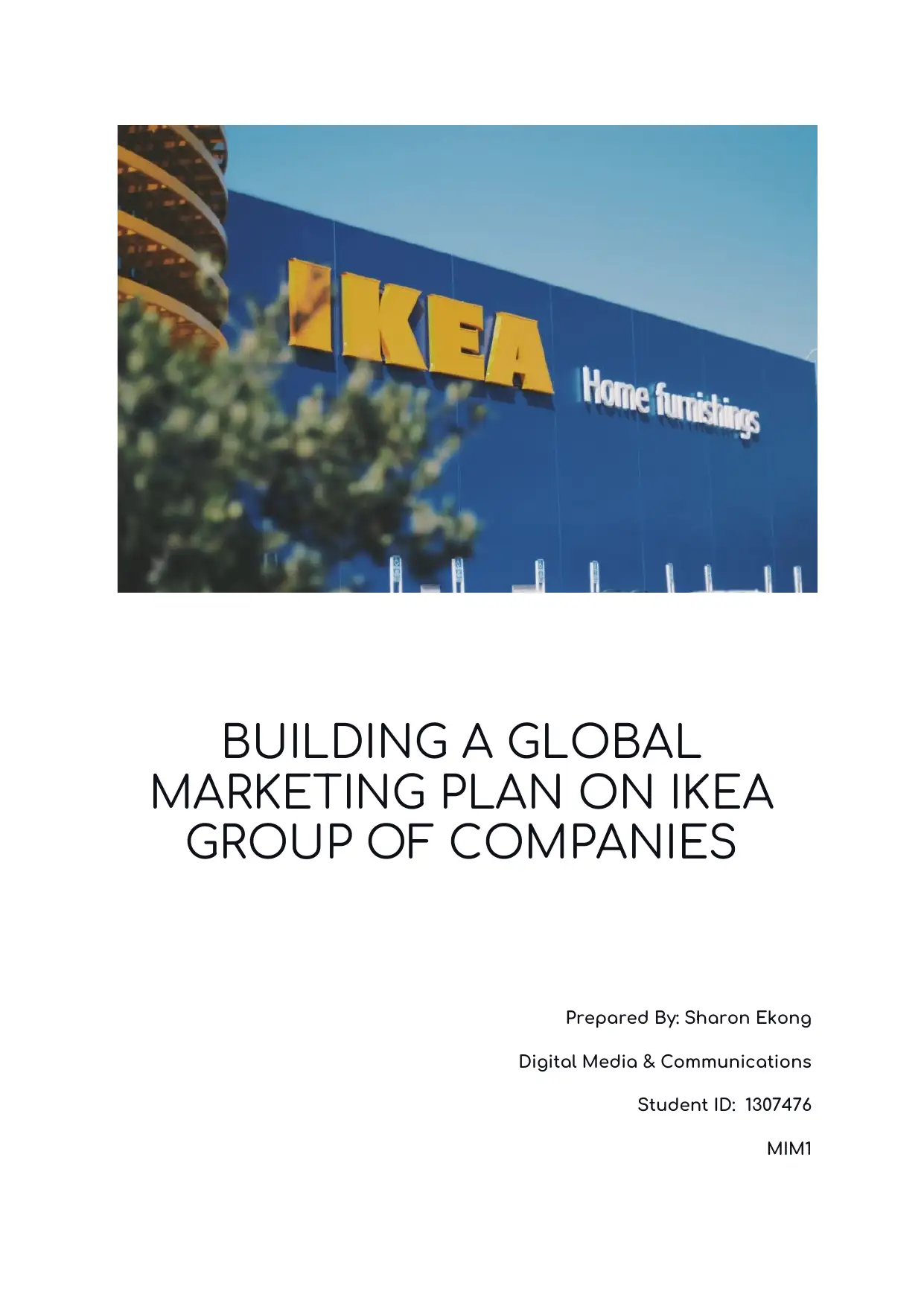
BUILDING A GLOBAL
MARKETING PLAN ON IKEA
GROUP OF COMPANIES
Prepared By: Sharon Ekong
Digital Media & Communications
Student ID: 1307476
MIM1
MARKETING PLAN ON IKEA
GROUP OF COMPANIES
Prepared By: Sharon Ekong
Digital Media & Communications
Student ID: 1307476
MIM1
Paraphrase This Document
Need a fresh take? Get an instant paraphrase of this document with our AI Paraphraser
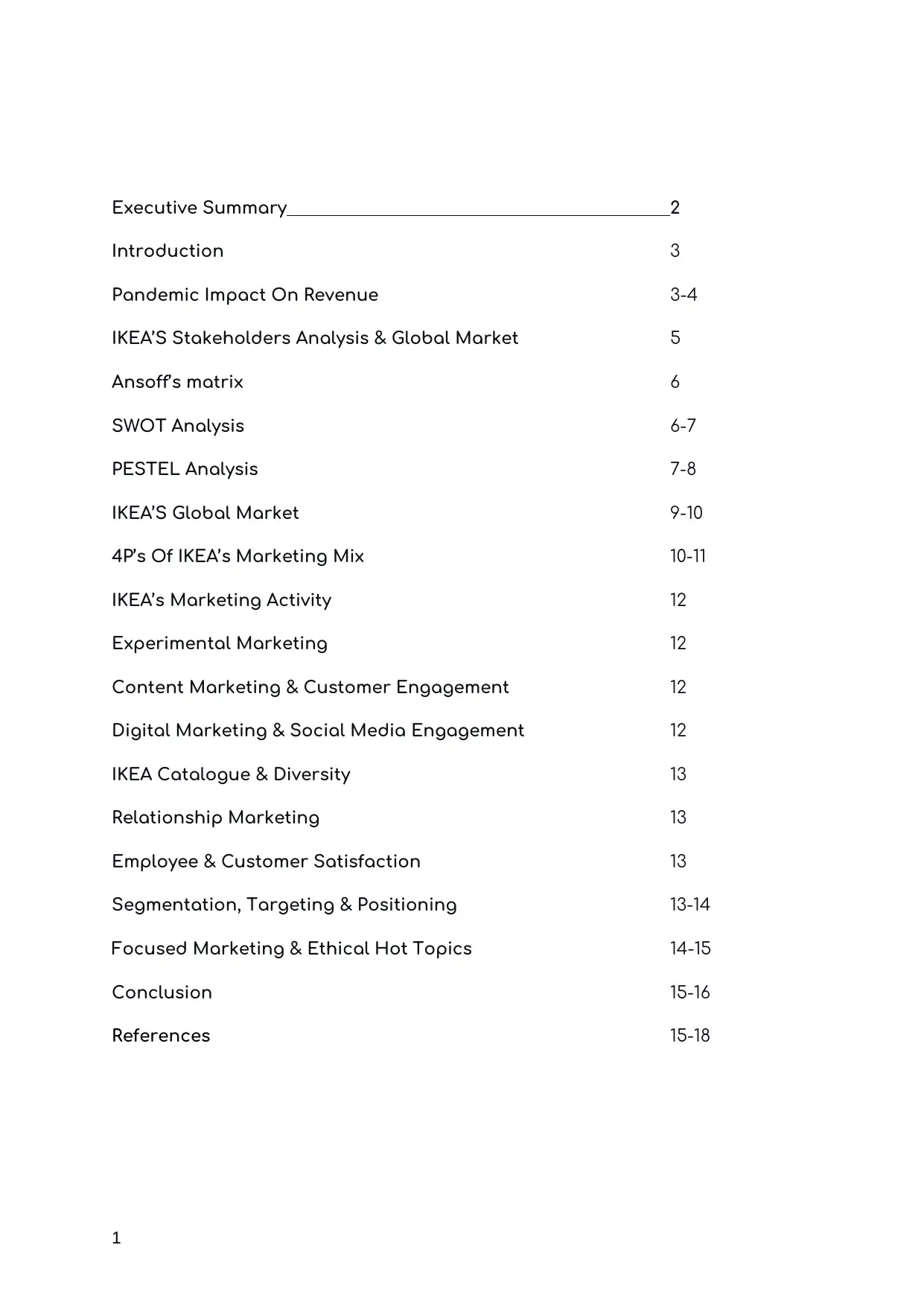
Executive Summary 2
Introduction 3
Pandemic Impact On Revenue 3-4
IKEA’S Stakeholders Analysis & Global Market 5
Ansoff’s matrix 6
SWOT Analysis 6-7
PESTEL Analysis 7-8
IKEA’S Global Market 9-10
4P’s Of IKEA’s Marketing Mix 10-11
IKEA’s Marketing Activity 12
Experimental Marketing 12
Content Marketing & Customer Engagement 12
Digital Marketing & Social Media Engagement 12
IKEA Catalogue & Diversity 13
Relationship Marketing 13
Employee & Customer Satisfaction 13
Segmentation, Targeting & Positioning 13-14
Focused Marketing & Ethical Hot Topics 14-15
Conclusion 15-16
References 15-18
1
Introduction 3
Pandemic Impact On Revenue 3-4
IKEA’S Stakeholders Analysis & Global Market 5
Ansoff’s matrix 6
SWOT Analysis 6-7
PESTEL Analysis 7-8
IKEA’S Global Market 9-10
4P’s Of IKEA’s Marketing Mix 10-11
IKEA’s Marketing Activity 12
Experimental Marketing 12
Content Marketing & Customer Engagement 12
Digital Marketing & Social Media Engagement 12
IKEA Catalogue & Diversity 13
Relationship Marketing 13
Employee & Customer Satisfaction 13
Segmentation, Targeting & Positioning 13-14
Focused Marketing & Ethical Hot Topics 14-15
Conclusion 15-16
References 15-18
1
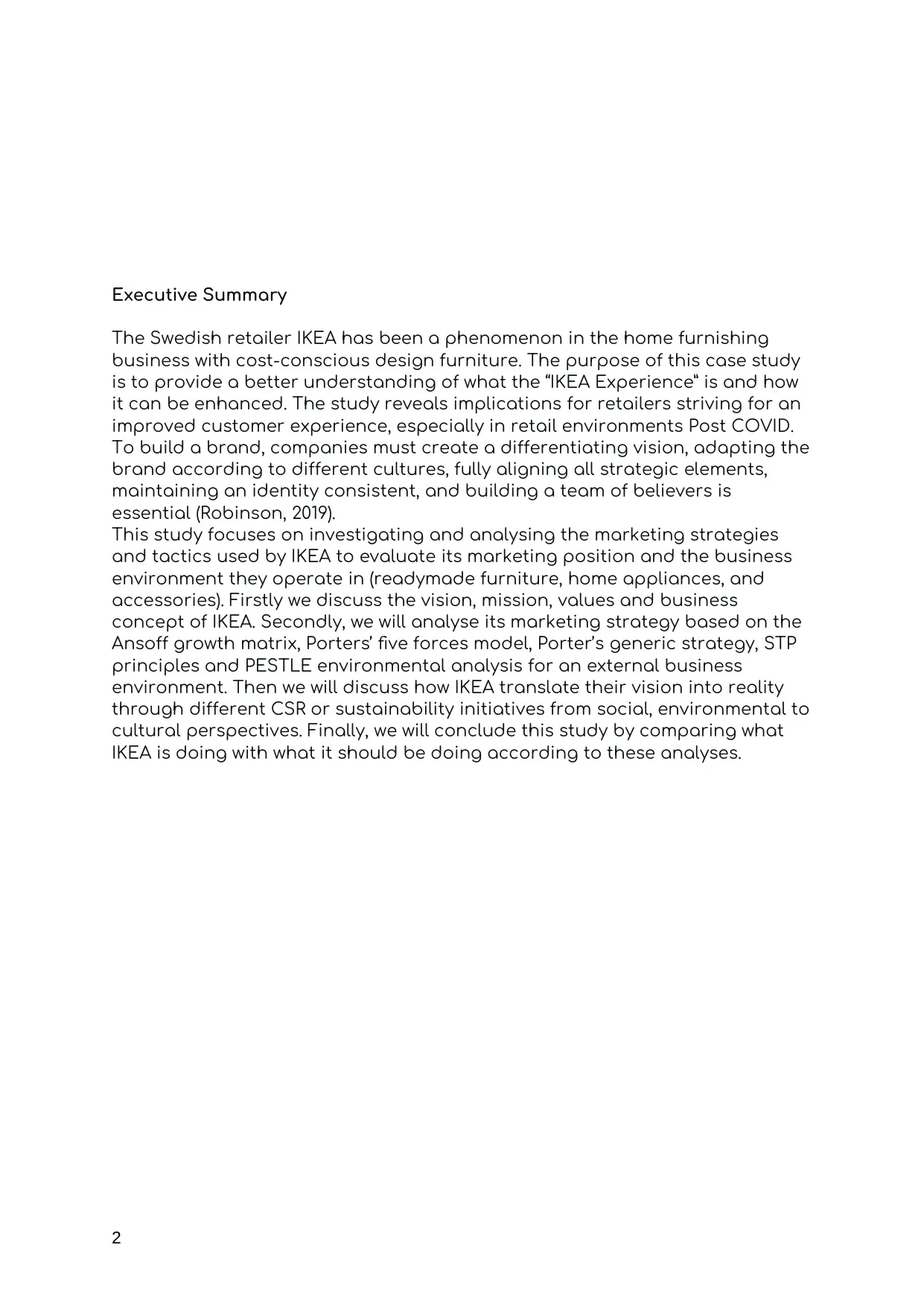
Executive Summary
The Swedish retailer IKEA has been a phenomenon in the home furnishing
business with cost-conscious design furniture. The purpose of this case study
is to provide a better understanding of what the “IKEA Experience” is and how
it can be enhanced. The study reveals implications for retailers striving for an
improved customer experience, especially in retail environments Post COVID.
To build a brand, companies must create a differentiating vision, adapting the
brand according to different cultures, fully aligning all strategic elements,
maintaining an identity consistent, and building a team of believers is
essential (Robinson, 2019).
This study focuses on investigating and analysing the marketing strategies
and tactics used by IKEA to evaluate its marketing position and the business
environment they operate in (readymade furniture, home appliances, and
accessories). Firstly we discuss the vision, mission, values and business
concept of IKEA. Secondly, we will analyse its marketing strategy based on the
Ansoff growth matrix, Porters’ five forces model, Porter’s generic strategy, STP
principles and PESTLE environmental analysis for an external business
environment. Then we will discuss how IKEA translate their vision into reality
through different CSR or sustainability initiatives from social, environmental to
cultural perspectives. Finally, we will conclude this study by comparing what
IKEA is doing with what it should be doing according to these analyses.
2
The Swedish retailer IKEA has been a phenomenon in the home furnishing
business with cost-conscious design furniture. The purpose of this case study
is to provide a better understanding of what the “IKEA Experience” is and how
it can be enhanced. The study reveals implications for retailers striving for an
improved customer experience, especially in retail environments Post COVID.
To build a brand, companies must create a differentiating vision, adapting the
brand according to different cultures, fully aligning all strategic elements,
maintaining an identity consistent, and building a team of believers is
essential (Robinson, 2019).
This study focuses on investigating and analysing the marketing strategies
and tactics used by IKEA to evaluate its marketing position and the business
environment they operate in (readymade furniture, home appliances, and
accessories). Firstly we discuss the vision, mission, values and business
concept of IKEA. Secondly, we will analyse its marketing strategy based on the
Ansoff growth matrix, Porters’ five forces model, Porter’s generic strategy, STP
principles and PESTLE environmental analysis for an external business
environment. Then we will discuss how IKEA translate their vision into reality
through different CSR or sustainability initiatives from social, environmental to
cultural perspectives. Finally, we will conclude this study by comparing what
IKEA is doing with what it should be doing according to these analyses.
2
⊘ This is a preview!⊘
Do you want full access?
Subscribe today to unlock all pages.

Trusted by 1+ million students worldwide
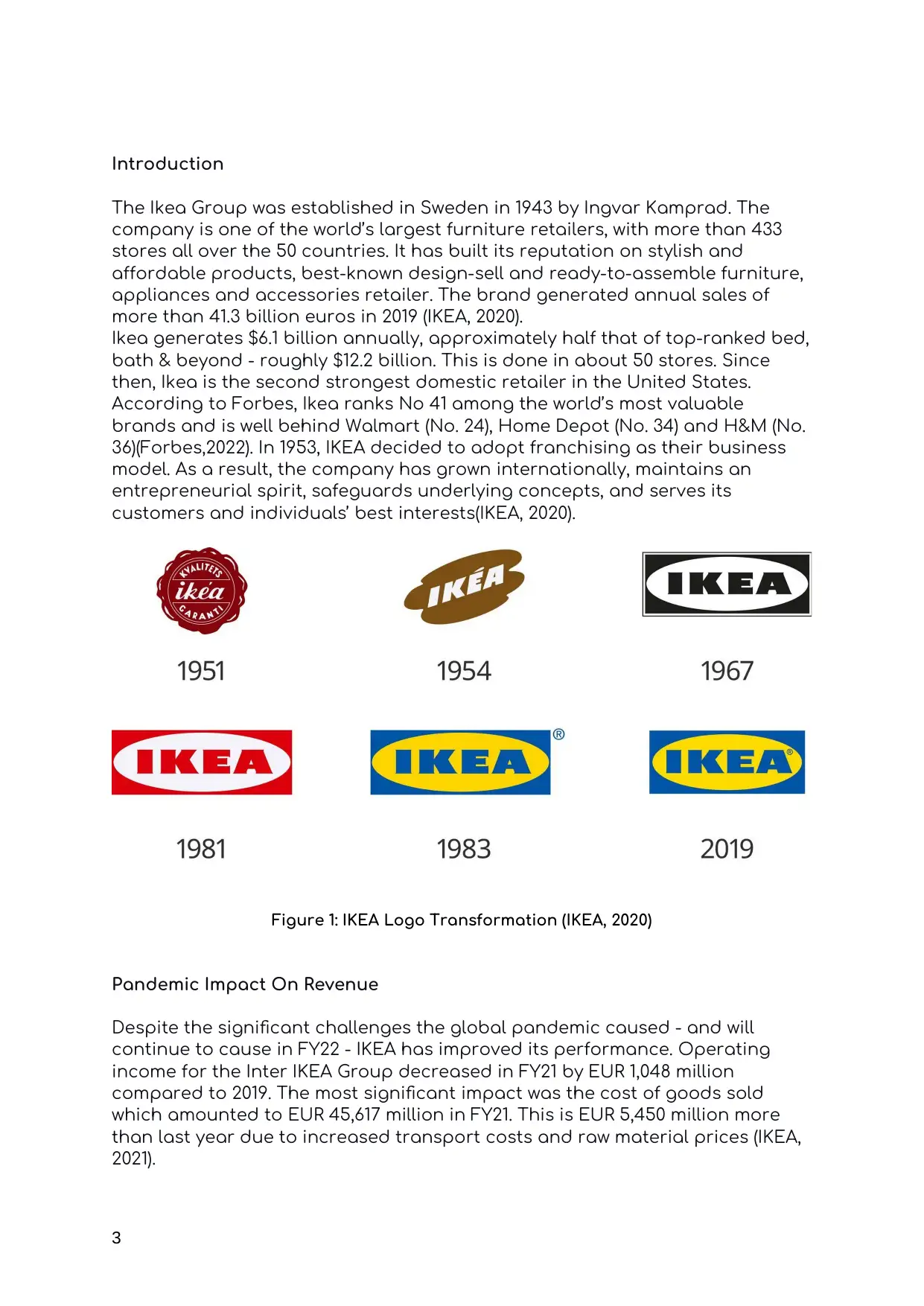
Introduction
The Ikea Group was established in Sweden in 1943 by Ingvar Kamprad. The
company is one of the world’s largest furniture retailers, with more than 433
stores all over the 50 countries. It has built its reputation on stylish and
affordable products, best-known design-sell and ready-to-assemble furniture,
appliances and accessories retailer. The brand generated annual sales of
more than 41.3 billion euros in 2019 (IKEA, 2020).
Ikea generates $6.1 billion annually, approximately half that of top-ranked bed,
bath & beyond - roughly $12.2 billion. This is done in about 50 stores. Since
then, Ikea is the second strongest domestic retailer in the United States.
According to Forbes, Ikea ranks No 41 among the world’s most valuable
brands and is well behind Walmart (No. 24), Home Depot (No. 34) and H&M (No.
36)(Forbes,2022). In 1953, IKEA decided to adopt franchising as their business
model. As a result, the company has grown internationally, maintains an
entrepreneurial spirit, safeguards underlying concepts, and serves its
customers and individuals’ best interests(IKEA, 2020).
Figure 1: IKEA Logo Transformation (IKEA, 2020)
Pandemic Impact On Revenue
Despite the significant challenges the global pandemic caused - and will
continue to cause in FY22 - IKEA has improved its performance. Operating
income for the Inter IKEA Group decreased in FY21 by EUR 1,048 million
compared to 2019. The most significant impact was the cost of goods sold
which amounted to EUR 45,617 million in FY21. This is EUR 5,450 million more
than last year due to increased transport costs and raw material prices (IKEA,
2021).
3
The Ikea Group was established in Sweden in 1943 by Ingvar Kamprad. The
company is one of the world’s largest furniture retailers, with more than 433
stores all over the 50 countries. It has built its reputation on stylish and
affordable products, best-known design-sell and ready-to-assemble furniture,
appliances and accessories retailer. The brand generated annual sales of
more than 41.3 billion euros in 2019 (IKEA, 2020).
Ikea generates $6.1 billion annually, approximately half that of top-ranked bed,
bath & beyond - roughly $12.2 billion. This is done in about 50 stores. Since
then, Ikea is the second strongest domestic retailer in the United States.
According to Forbes, Ikea ranks No 41 among the world’s most valuable
brands and is well behind Walmart (No. 24), Home Depot (No. 34) and H&M (No.
36)(Forbes,2022). In 1953, IKEA decided to adopt franchising as their business
model. As a result, the company has grown internationally, maintains an
entrepreneurial spirit, safeguards underlying concepts, and serves its
customers and individuals’ best interests(IKEA, 2020).
Figure 1: IKEA Logo Transformation (IKEA, 2020)
Pandemic Impact On Revenue
Despite the significant challenges the global pandemic caused - and will
continue to cause in FY22 - IKEA has improved its performance. Operating
income for the Inter IKEA Group decreased in FY21 by EUR 1,048 million
compared to 2019. The most significant impact was the cost of goods sold
which amounted to EUR 45,617 million in FY21. This is EUR 5,450 million more
than last year due to increased transport costs and raw material prices (IKEA,
2021).
3
Paraphrase This Document
Need a fresh take? Get an instant paraphrase of this document with our AI Paraphraser
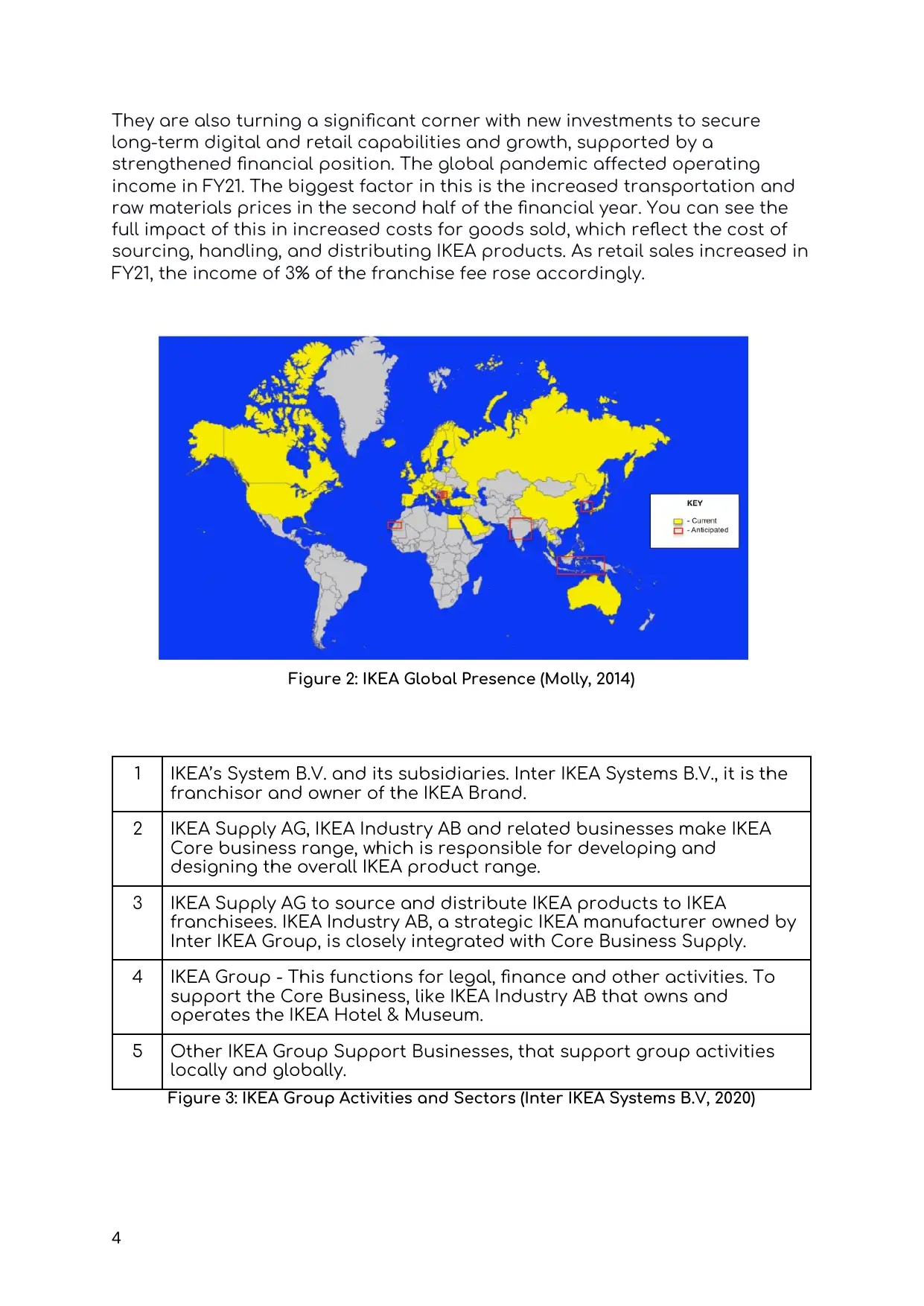
They are also turning a significant corner with new investments to secure
long-term digital and retail capabilities and growth, supported by a
strengthened financial position. The global pandemic affected operating
income in FY21. The biggest factor in this is the increased transportation and
raw materials prices in the second half of the financial year. You can see the
full impact of this in increased costs for goods sold, which reflect the cost of
sourcing, handling, and distributing IKEA products. As retail sales increased in
FY21, the income of 3% of the franchise fee rose accordingly.
Figure 2: IKEA Global Presence (Molly, 2014)
1 IKEA’s System B.V. and its subsidiaries. Inter IKEA Systems B.V., it is the
franchisor and owner of the IKEA Brand.
2 IKEA Supply AG, IKEA Industry AB and related businesses make IKEA
Core business range, which is responsible for developing and
designing the overall IKEA product range.
3 IKEA Supply AG to source and distribute IKEA products to IKEA
franchisees. IKEA Industry AB, a strategic IKEA manufacturer owned by
Inter IKEA Group, is closely integrated with Core Business Supply.
4 IKEA Group - This functions for legal, finance and other activities. To
support the Core Business, like IKEA Industry AB that owns and
operates the IKEA Hotel & Museum.
5 Other IKEA Group Support Businesses, that support group activities
locally and globally.
Figure 3: IKEA Group Activities and Sectors (Inter IKEA Systems B.V, 2020)
4
long-term digital and retail capabilities and growth, supported by a
strengthened financial position. The global pandemic affected operating
income in FY21. The biggest factor in this is the increased transportation and
raw materials prices in the second half of the financial year. You can see the
full impact of this in increased costs for goods sold, which reflect the cost of
sourcing, handling, and distributing IKEA products. As retail sales increased in
FY21, the income of 3% of the franchise fee rose accordingly.
Figure 2: IKEA Global Presence (Molly, 2014)
1 IKEA’s System B.V. and its subsidiaries. Inter IKEA Systems B.V., it is the
franchisor and owner of the IKEA Brand.
2 IKEA Supply AG, IKEA Industry AB and related businesses make IKEA
Core business range, which is responsible for developing and
designing the overall IKEA product range.
3 IKEA Supply AG to source and distribute IKEA products to IKEA
franchisees. IKEA Industry AB, a strategic IKEA manufacturer owned by
Inter IKEA Group, is closely integrated with Core Business Supply.
4 IKEA Group - This functions for legal, finance and other activities. To
support the Core Business, like IKEA Industry AB that owns and
operates the IKEA Hotel & Museum.
5 Other IKEA Group Support Businesses, that support group activities
locally and globally.
Figure 3: IKEA Group Activities and Sectors (Inter IKEA Systems B.V, 2020)
4
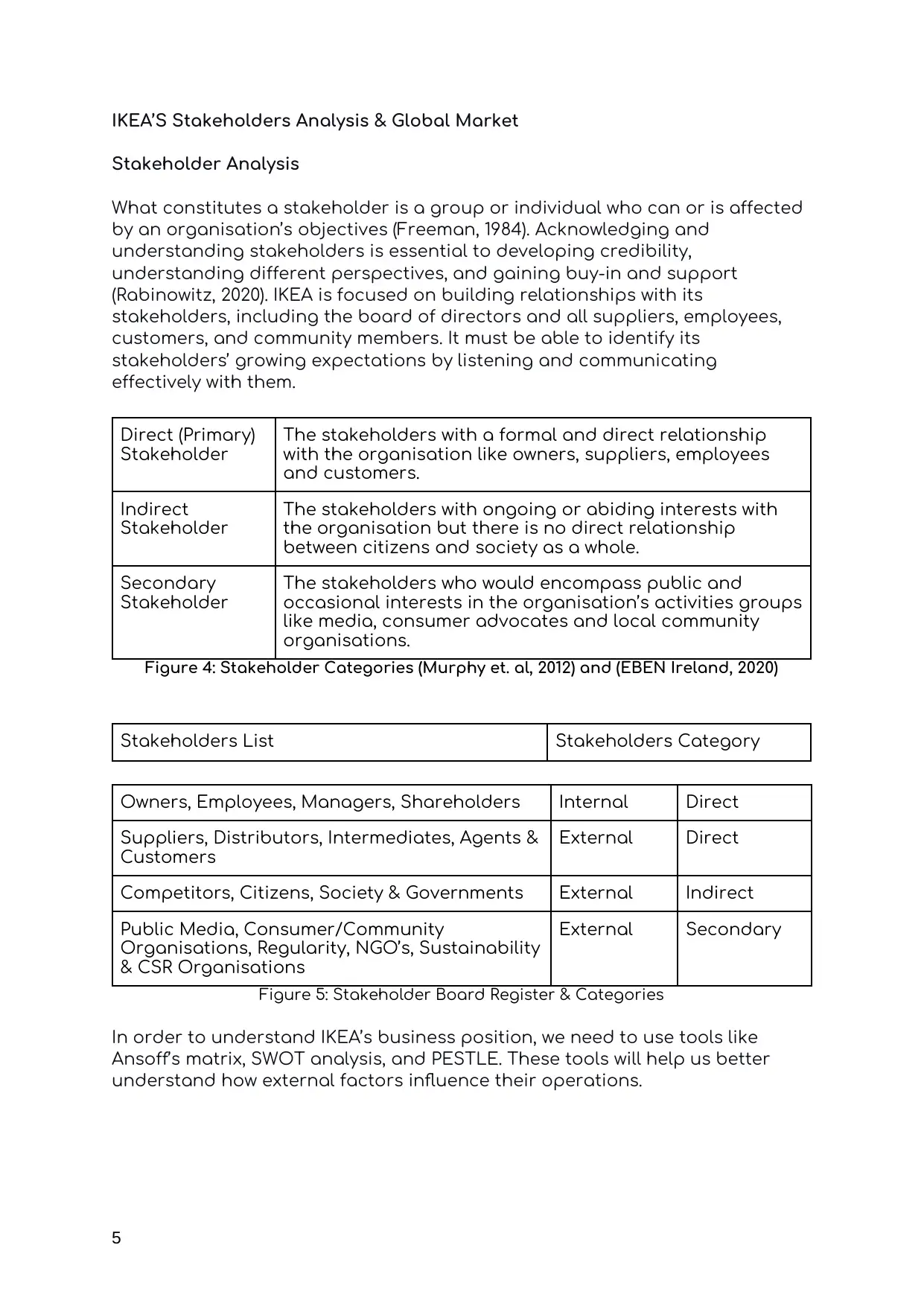
IKEA’S Stakeholders Analysis & Global Market
Stakeholder Analysis
What constitutes a stakeholder is a group or individual who can or is affected
by an organisation’s objectives (Freeman, 1984). Acknowledging and
understanding stakeholders is essential to developing credibility,
understanding different perspectives, and gaining buy-in and support
(Rabinowitz, 2020). IKEA is focused on building relationships with its
stakeholders, including the board of directors and all suppliers, employees,
customers, and community members. It must be able to identify its
stakeholders’ growing expectations by listening and communicating
effectively with them.
Direct (Primary)
Stakeholder
The stakeholders with a formal and direct relationship
with the organisation like owners, suppliers, employees
and customers.
Indirect
Stakeholder
The stakeholders with ongoing or abiding interests with
the organisation but there is no direct relationship
between citizens and society as a whole.
Secondary
Stakeholder
The stakeholders who would encompass public and
occasional interests in the organisation’s activities groups
like media, consumer advocates and local community
organisations.
Figure 4: Stakeholder Categories (Murphy et. al, 2012) and (EBEN Ireland, 2020)
Stakeholders List Stakeholders Category
Owners, Employees, Managers, Shareholders Internal Direct
Suppliers, Distributors, Intermediates, Agents &
Customers
External Direct
Competitors, Citizens, Society & Governments External Indirect
Public Media, Consumer/Community
Organisations, Regularity, NGO’s, Sustainability
& CSR Organisations
External Secondary
Figure 5: Stakeholder Board Register & Categories
In order to understand IKEA’s business position, we need to use tools like
Ansoff’s matrix, SWOT analysis, and PESTLE. These tools will help us better
understand how external factors influence their operations.
5
Stakeholder Analysis
What constitutes a stakeholder is a group or individual who can or is affected
by an organisation’s objectives (Freeman, 1984). Acknowledging and
understanding stakeholders is essential to developing credibility,
understanding different perspectives, and gaining buy-in and support
(Rabinowitz, 2020). IKEA is focused on building relationships with its
stakeholders, including the board of directors and all suppliers, employees,
customers, and community members. It must be able to identify its
stakeholders’ growing expectations by listening and communicating
effectively with them.
Direct (Primary)
Stakeholder
The stakeholders with a formal and direct relationship
with the organisation like owners, suppliers, employees
and customers.
Indirect
Stakeholder
The stakeholders with ongoing or abiding interests with
the organisation but there is no direct relationship
between citizens and society as a whole.
Secondary
Stakeholder
The stakeholders who would encompass public and
occasional interests in the organisation’s activities groups
like media, consumer advocates and local community
organisations.
Figure 4: Stakeholder Categories (Murphy et. al, 2012) and (EBEN Ireland, 2020)
Stakeholders List Stakeholders Category
Owners, Employees, Managers, Shareholders Internal Direct
Suppliers, Distributors, Intermediates, Agents &
Customers
External Direct
Competitors, Citizens, Society & Governments External Indirect
Public Media, Consumer/Community
Organisations, Regularity, NGO’s, Sustainability
& CSR Organisations
External Secondary
Figure 5: Stakeholder Board Register & Categories
In order to understand IKEA’s business position, we need to use tools like
Ansoff’s matrix, SWOT analysis, and PESTLE. These tools will help us better
understand how external factors influence their operations.
5
⊘ This is a preview!⊘
Do you want full access?
Subscribe today to unlock all pages.

Trusted by 1+ million students worldwide
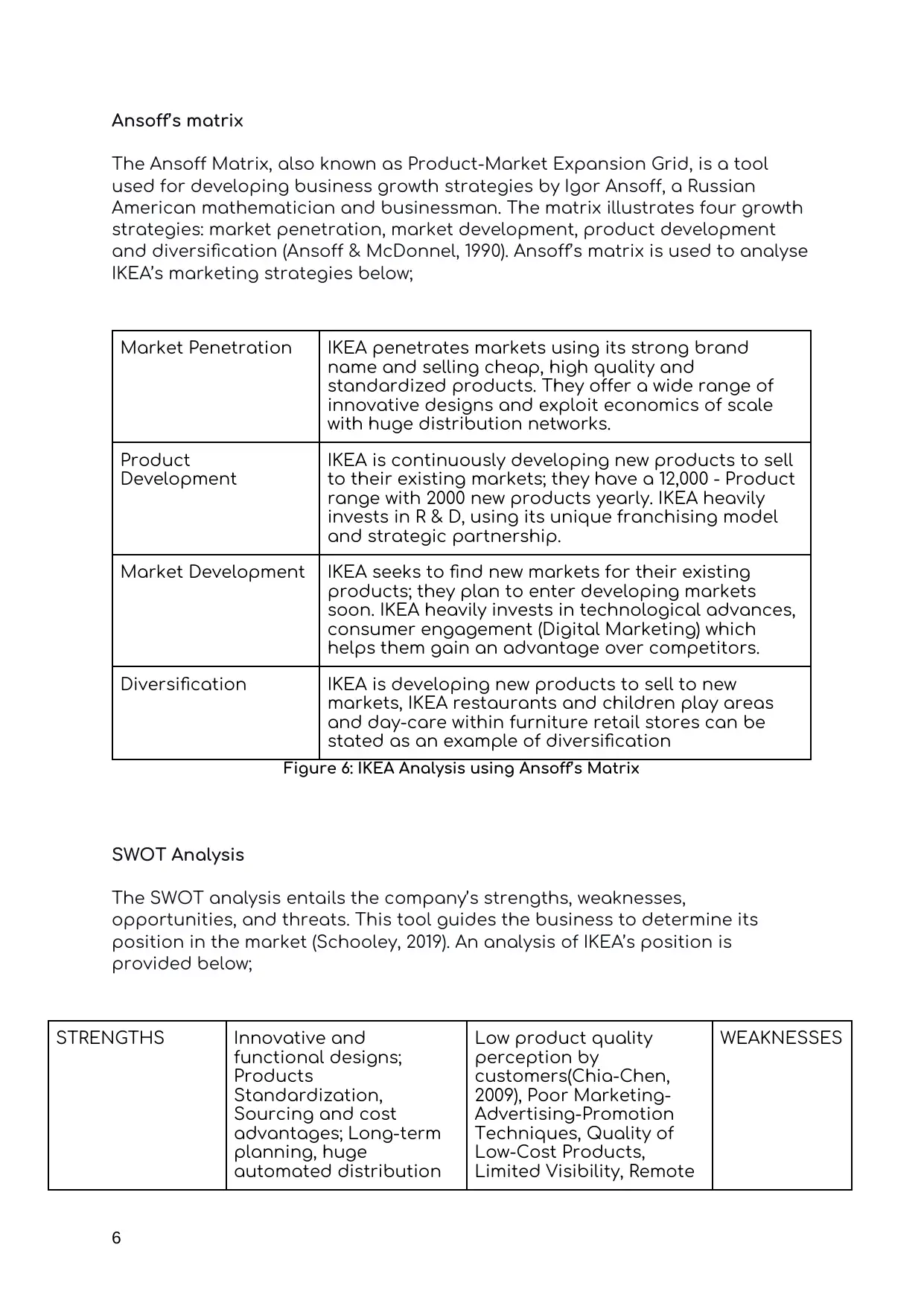
Ansoff’s matrix
The Ansoff Matrix, also known as Product-Market Expansion Grid, is a tool
used for developing business growth strategies by Igor Ansoff, a Russian
American mathematician and businessman. The matrix illustrates four growth
strategies: market penetration, market development, product development
and diversification (Ansoff & McDonnel, 1990). Ansoff’s matrix is used to analyse
IKEA’s marketing strategies below;
Market Penetration IKEA penetrates markets using its strong brand
name and selling cheap, high quality and
standardized products. They offer a wide range of
innovative designs and exploit economics of scale
with huge distribution networks.
Product
Development
IKEA is continuously developing new products to sell
to their existing markets; they have a 12,000 - Product
range with 2000 new products yearly. IKEA heavily
invests in R & D, using its unique franchising model
and strategic partnership.
Market Development IKEA seeks to find new markets for their existing
products; they plan to enter developing markets
soon. IKEA heavily invests in technological advances,
consumer engagement (Digital Marketing) which
helps them gain an advantage over competitors.
Diversification IKEA is developing new products to sell to new
markets, IKEA restaurants and children play areas
and day-care within furniture retail stores can be
stated as an example of diversification
Figure 6: IKEA Analysis using Ansoff’s Matrix
SWOT Analysis
The SWOT analysis entails the company’s strengths, weaknesses,
opportunities, and threats. This tool guides the business to determine its
position in the market (Schooley, 2019). An analysis of IKEA’s position is
provided below;
STRENGTHS Innovative and
functional designs;
Products
Standardization,
Sourcing and cost
advantages; Long-term
planning, huge
automated distribution
Low product quality
perception by
customers(Chia-Chen,
2009), Poor Marketing-
Advertising-Promotion
Techniques, Quality of
Low-Cost Products,
Limited Visibility, Remote
WEAKNESSES
6
The Ansoff Matrix, also known as Product-Market Expansion Grid, is a tool
used for developing business growth strategies by Igor Ansoff, a Russian
American mathematician and businessman. The matrix illustrates four growth
strategies: market penetration, market development, product development
and diversification (Ansoff & McDonnel, 1990). Ansoff’s matrix is used to analyse
IKEA’s marketing strategies below;
Market Penetration IKEA penetrates markets using its strong brand
name and selling cheap, high quality and
standardized products. They offer a wide range of
innovative designs and exploit economics of scale
with huge distribution networks.
Product
Development
IKEA is continuously developing new products to sell
to their existing markets; they have a 12,000 - Product
range with 2000 new products yearly. IKEA heavily
invests in R & D, using its unique franchising model
and strategic partnership.
Market Development IKEA seeks to find new markets for their existing
products; they plan to enter developing markets
soon. IKEA heavily invests in technological advances,
consumer engagement (Digital Marketing) which
helps them gain an advantage over competitors.
Diversification IKEA is developing new products to sell to new
markets, IKEA restaurants and children play areas
and day-care within furniture retail stores can be
stated as an example of diversification
Figure 6: IKEA Analysis using Ansoff’s Matrix
SWOT Analysis
The SWOT analysis entails the company’s strengths, weaknesses,
opportunities, and threats. This tool guides the business to determine its
position in the market (Schooley, 2019). An analysis of IKEA’s position is
provided below;
STRENGTHS Innovative and
functional designs;
Products
Standardization,
Sourcing and cost
advantages; Long-term
planning, huge
automated distribution
Low product quality
perception by
customers(Chia-Chen,
2009), Poor Marketing-
Advertising-Promotion
Techniques, Quality of
Low-Cost Products,
Limited Visibility, Remote
WEAKNESSES
6
Paraphrase This Document
Need a fresh take? Get an instant paraphrase of this document with our AI Paraphraser
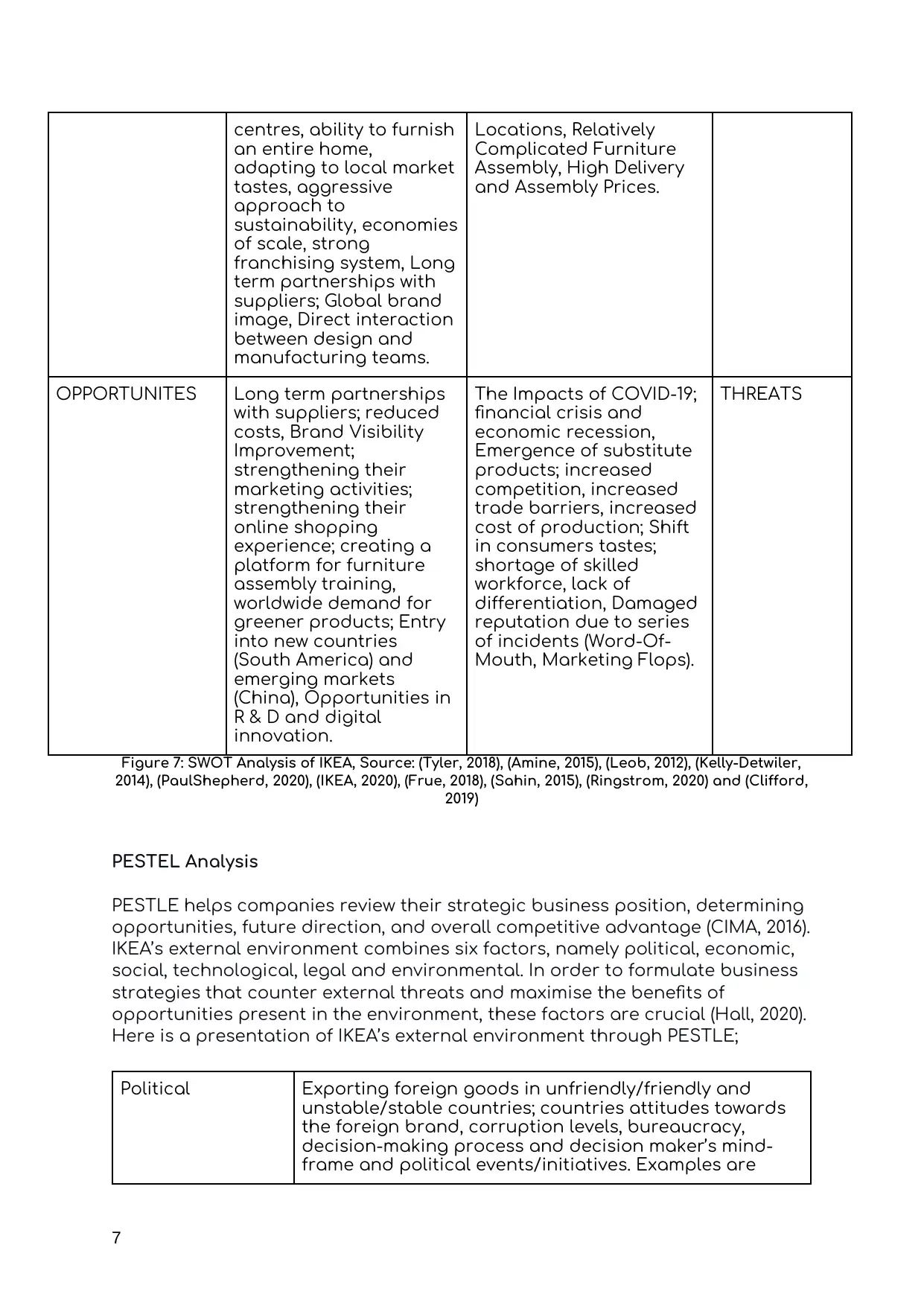
centres, ability to furnish
an entire home,
adapting to local market
tastes, aggressive
approach to
sustainability, economies
of scale, strong
franchising system, Long
term partnerships with
suppliers; Global brand
image, Direct interaction
between design and
manufacturing teams.
Locations, Relatively
Complicated Furniture
Assembly, High Delivery
and Assembly Prices.
OPPORTUNITES Long term partnerships
with suppliers; reduced
costs, Brand Visibility
Improvement;
strengthening their
marketing activities;
strengthening their
online shopping
experience; creating a
platform for furniture
assembly training,
worldwide demand for
greener products; Entry
into new countries
(South America) and
emerging markets
(China), Opportunities in
R & D and digital
innovation.
The Impacts of COVID-19;
financial crisis and
economic recession,
Emergence of substitute
products; increased
competition, increased
trade barriers, increased
cost of production; Shift
in consumers tastes;
shortage of skilled
workforce, lack of
differentiation, Damaged
reputation due to series
of incidents (Word-Of-
Mouth, Marketing Flops).
THREATS
Figure 7: SWOT Analysis of IKEA, Source: (Tyler, 2018), (Amine, 2015), (Leob, 2012), (Kelly-Detwiler,
2014), (PaulShepherd, 2020), (IKEA, 2020), (Frue, 2018), (Sahin, 2015), (Ringstrom, 2020) and (Clifford,
2019)
PESTEL Analysis
PESTLE helps companies review their strategic business position, determining
opportunities, future direction, and overall competitive advantage (CIMA, 2016).
IKEA’s external environment combines six factors, namely political, economic,
social, technological, legal and environmental. In order to formulate business
strategies that counter external threats and maximise the benefits of
opportunities present in the environment, these factors are crucial (Hall, 2020).
Here is a presentation of IKEA’s external environment through PESTLE;
Political Exporting foreign goods in unfriendly/friendly and
unstable/stable countries; countries attitudes towards
the foreign brand, corruption levels, bureaucracy,
decision-making process and decision maker’s mind-
frame and political events/initiatives. Examples are
7
an entire home,
adapting to local market
tastes, aggressive
approach to
sustainability, economies
of scale, strong
franchising system, Long
term partnerships with
suppliers; Global brand
image, Direct interaction
between design and
manufacturing teams.
Locations, Relatively
Complicated Furniture
Assembly, High Delivery
and Assembly Prices.
OPPORTUNITES Long term partnerships
with suppliers; reduced
costs, Brand Visibility
Improvement;
strengthening their
marketing activities;
strengthening their
online shopping
experience; creating a
platform for furniture
assembly training,
worldwide demand for
greener products; Entry
into new countries
(South America) and
emerging markets
(China), Opportunities in
R & D and digital
innovation.
The Impacts of COVID-19;
financial crisis and
economic recession,
Emergence of substitute
products; increased
competition, increased
trade barriers, increased
cost of production; Shift
in consumers tastes;
shortage of skilled
workforce, lack of
differentiation, Damaged
reputation due to series
of incidents (Word-Of-
Mouth, Marketing Flops).
THREATS
Figure 7: SWOT Analysis of IKEA, Source: (Tyler, 2018), (Amine, 2015), (Leob, 2012), (Kelly-Detwiler,
2014), (PaulShepherd, 2020), (IKEA, 2020), (Frue, 2018), (Sahin, 2015), (Ringstrom, 2020) and (Clifford,
2019)
PESTEL Analysis
PESTLE helps companies review their strategic business position, determining
opportunities, future direction, and overall competitive advantage (CIMA, 2016).
IKEA’s external environment combines six factors, namely political, economic,
social, technological, legal and environmental. In order to formulate business
strategies that counter external threats and maximise the benefits of
opportunities present in the environment, these factors are crucial (Hall, 2020).
Here is a presentation of IKEA’s external environment through PESTLE;
Political Exporting foreign goods in unfriendly/friendly and
unstable/stable countries; countries attitudes towards
the foreign brand, corruption levels, bureaucracy,
decision-making process and decision maker’s mind-
frame and political events/initiatives. Examples are
7
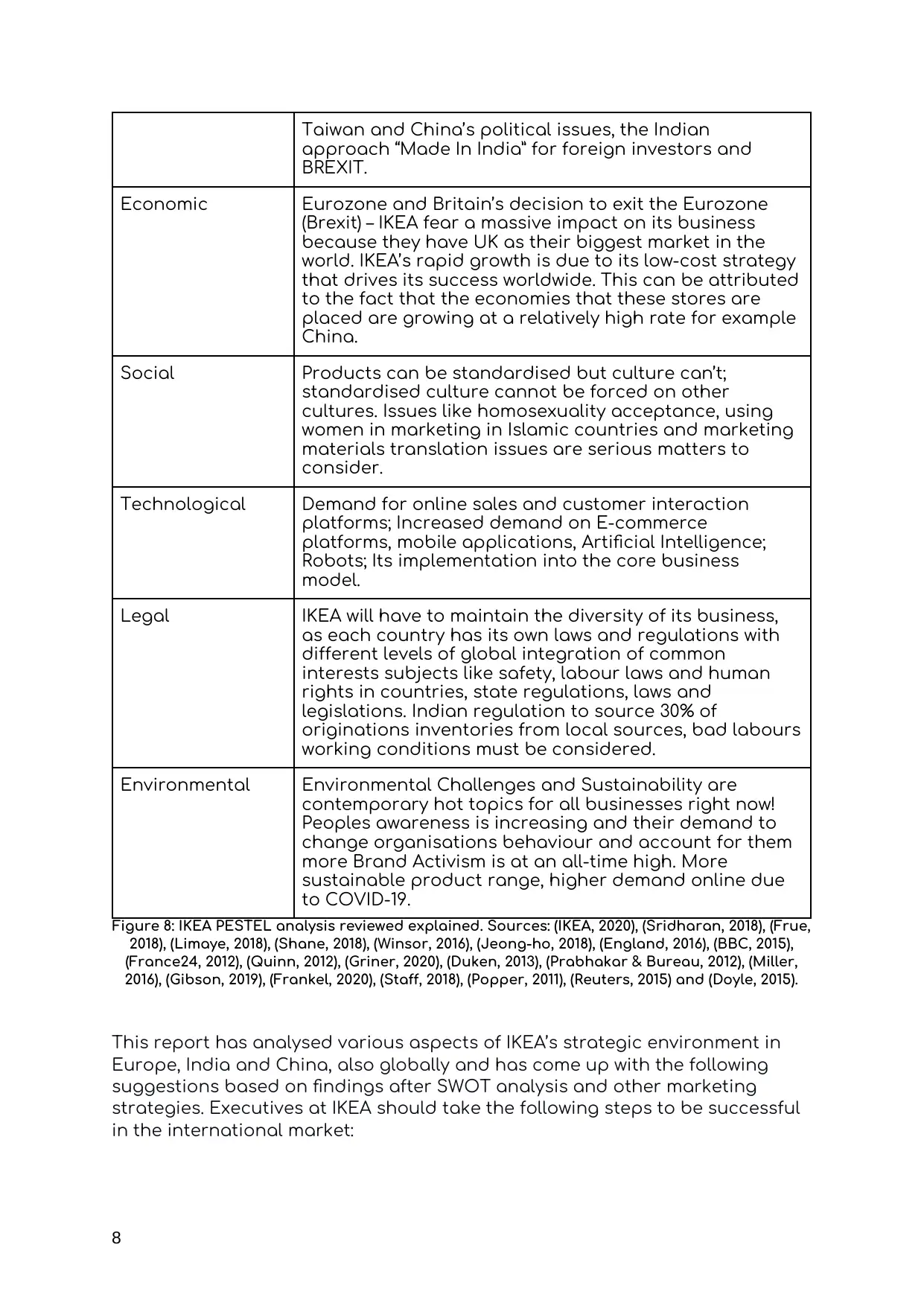
Taiwan and China’s political issues, the Indian
approach “Made In India” for foreign investors and
BREXIT.
Economic Eurozone and Britain’s decision to exit the Eurozone
(Brexit) – IKEA fear a massive impact on its business
because they have UK as their biggest market in the
world. IKEA’s rapid growth is due to its low-cost strategy
that drives its success worldwide. This can be attributed
to the fact that the economies that these stores are
placed are growing at a relatively high rate for example
China.
Social Products can be standardised but culture can’t;
standardised culture cannot be forced on other
cultures. Issues like homosexuality acceptance, using
women in marketing in Islamic countries and marketing
materials translation issues are serious matters to
consider.
Technological Demand for online sales and customer interaction
platforms; Increased demand on E-commerce
platforms, mobile applications, Artificial Intelligence;
Robots; Its implementation into the core business
model.
Legal IKEA will have to maintain the diversity of its business,
as each country has its own laws and regulations with
different levels of global integration of common
interests subjects like safety, labour laws and human
rights in countries, state regulations, laws and
legislations. Indian regulation to source 30% of
originations inventories from local sources, bad labours
working conditions must be considered.
Environmental Environmental Challenges and Sustainability are
contemporary hot topics for all businesses right now!
Peoples awareness is increasing and their demand to
change organisations behaviour and account for them
more Brand Activism is at an all-time high. More
sustainable product range, higher demand online due
to COVID-19.
Figure 8: IKEA PESTEL analysis reviewed explained. Sources: (IKEA, 2020), (Sridharan, 2018), (Frue,
2018), (Limaye, 2018), (Shane, 2018), (Winsor, 2016), (Jeong-ho, 2018), (England, 2016), (BBC, 2015),
(France24, 2012), (Quinn, 2012), (Griner, 2020), (Duken, 2013), (Prabhakar & Bureau, 2012), (Miller,
2016), (Gibson, 2019), (Frankel, 2020), (Staff, 2018), (Popper, 2011), (Reuters, 2015) and (Doyle, 2015).
This report has analysed various aspects of IKEA’s strategic environment in
Europe, India and China, also globally and has come up with the following
suggestions based on findings after SWOT analysis and other marketing
strategies. Executives at IKEA should take the following steps to be successful
in the international market:
8
approach “Made In India” for foreign investors and
BREXIT.
Economic Eurozone and Britain’s decision to exit the Eurozone
(Brexit) – IKEA fear a massive impact on its business
because they have UK as their biggest market in the
world. IKEA’s rapid growth is due to its low-cost strategy
that drives its success worldwide. This can be attributed
to the fact that the economies that these stores are
placed are growing at a relatively high rate for example
China.
Social Products can be standardised but culture can’t;
standardised culture cannot be forced on other
cultures. Issues like homosexuality acceptance, using
women in marketing in Islamic countries and marketing
materials translation issues are serious matters to
consider.
Technological Demand for online sales and customer interaction
platforms; Increased demand on E-commerce
platforms, mobile applications, Artificial Intelligence;
Robots; Its implementation into the core business
model.
Legal IKEA will have to maintain the diversity of its business,
as each country has its own laws and regulations with
different levels of global integration of common
interests subjects like safety, labour laws and human
rights in countries, state regulations, laws and
legislations. Indian regulation to source 30% of
originations inventories from local sources, bad labours
working conditions must be considered.
Environmental Environmental Challenges and Sustainability are
contemporary hot topics for all businesses right now!
Peoples awareness is increasing and their demand to
change organisations behaviour and account for them
more Brand Activism is at an all-time high. More
sustainable product range, higher demand online due
to COVID-19.
Figure 8: IKEA PESTEL analysis reviewed explained. Sources: (IKEA, 2020), (Sridharan, 2018), (Frue,
2018), (Limaye, 2018), (Shane, 2018), (Winsor, 2016), (Jeong-ho, 2018), (England, 2016), (BBC, 2015),
(France24, 2012), (Quinn, 2012), (Griner, 2020), (Duken, 2013), (Prabhakar & Bureau, 2012), (Miller,
2016), (Gibson, 2019), (Frankel, 2020), (Staff, 2018), (Popper, 2011), (Reuters, 2015) and (Doyle, 2015).
This report has analysed various aspects of IKEA’s strategic environment in
Europe, India and China, also globally and has come up with the following
suggestions based on findings after SWOT analysis and other marketing
strategies. Executives at IKEA should take the following steps to be successful
in the international market:
8
⊘ This is a preview!⊘
Do you want full access?
Subscribe today to unlock all pages.

Trusted by 1+ million students worldwide
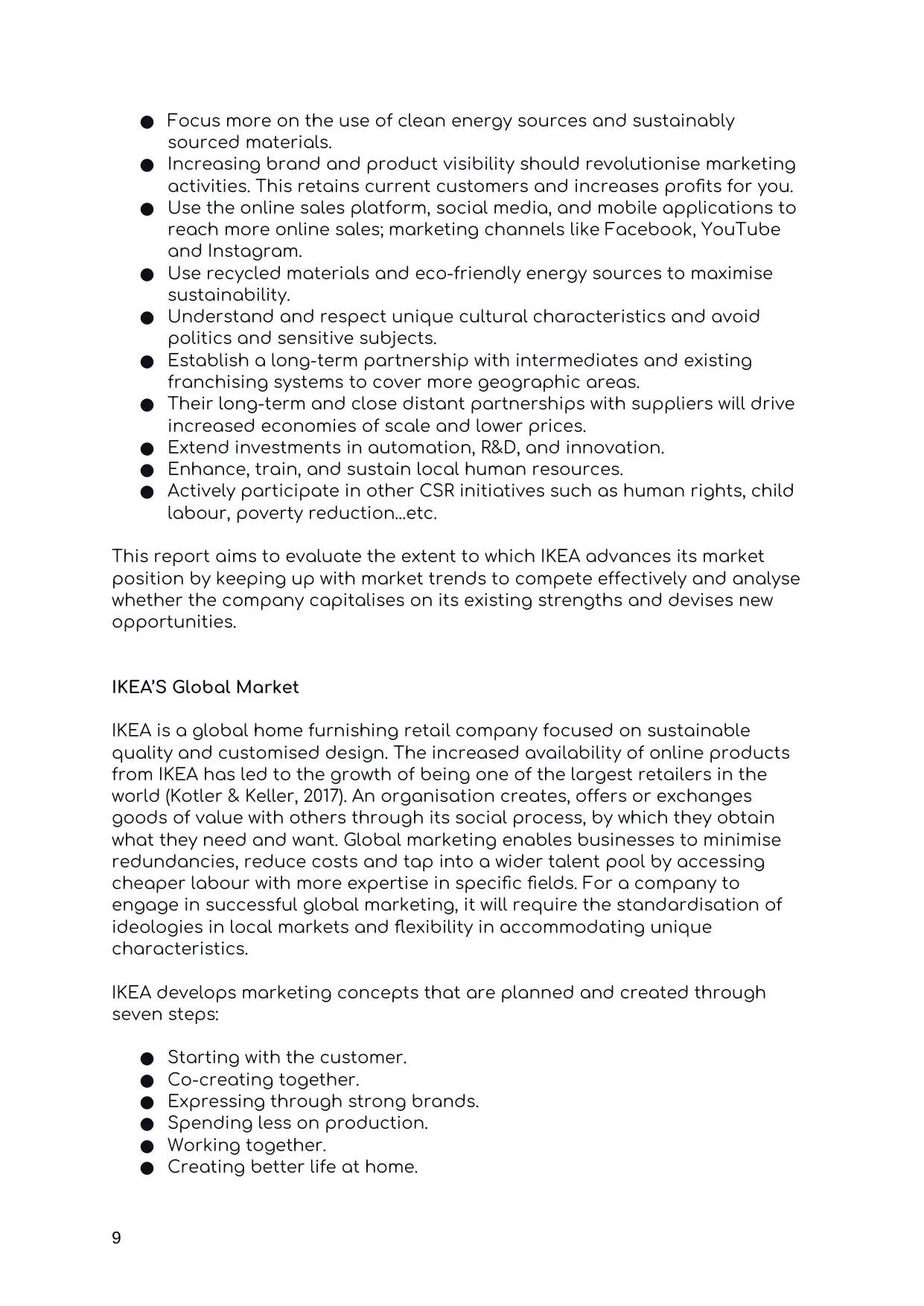
● Focus more on the use of clean energy sources and sustainably
sourced materials.
● Increasing brand and product visibility should revolutionise marketing
activities. This retains current customers and increases profits for you.
● Use the online sales platform, social media, and mobile applications to
reach more online sales; marketing channels like Facebook, YouTube
and Instagram.
● Use recycled materials and eco-friendly energy sources to maximise
sustainability.
● Understand and respect unique cultural characteristics and avoid
politics and sensitive subjects.
● Establish a long-term partnership with intermediates and existing
franchising systems to cover more geographic areas.
● Their long-term and close distant partnerships with suppliers will drive
increased economies of scale and lower prices.
● Extend investments in automation, R&D, and innovation.
● Enhance, train, and sustain local human resources.
● Actively participate in other CSR initiatives such as human rights, child
labour, poverty reduction...etc.
This report aims to evaluate the extent to which IKEA advances its market
position by keeping up with market trends to compete effectively and analyse
whether the company capitalises on its existing strengths and devises new
opportunities.
IKEA’S Global Market
IKEA is a global home furnishing retail company focused on sustainable
quality and customised design. The increased availability of online products
from IKEA has led to the growth of being one of the largest retailers in the
world (Kotler & Keller, 2017). An organisation creates, offers or exchanges
goods of value with others through its social process, by which they obtain
what they need and want. Global marketing enables businesses to minimise
redundancies, reduce costs and tap into a wider talent pool by accessing
cheaper labour with more expertise in specific fields. For a company to
engage in successful global marketing, it will require the standardisation of
ideologies in local markets and flexibility in accommodating unique
characteristics.
IKEA develops marketing concepts that are planned and created through
seven steps:
● Starting with the customer.
● Co-creating together.
● Expressing through strong brands.
● Spending less on production.
● Working together.
● Creating better life at home.
9
sourced materials.
● Increasing brand and product visibility should revolutionise marketing
activities. This retains current customers and increases profits for you.
● Use the online sales platform, social media, and mobile applications to
reach more online sales; marketing channels like Facebook, YouTube
and Instagram.
● Use recycled materials and eco-friendly energy sources to maximise
sustainability.
● Understand and respect unique cultural characteristics and avoid
politics and sensitive subjects.
● Establish a long-term partnership with intermediates and existing
franchising systems to cover more geographic areas.
● Their long-term and close distant partnerships with suppliers will drive
increased economies of scale and lower prices.
● Extend investments in automation, R&D, and innovation.
● Enhance, train, and sustain local human resources.
● Actively participate in other CSR initiatives such as human rights, child
labour, poverty reduction...etc.
This report aims to evaluate the extent to which IKEA advances its market
position by keeping up with market trends to compete effectively and analyse
whether the company capitalises on its existing strengths and devises new
opportunities.
IKEA’S Global Market
IKEA is a global home furnishing retail company focused on sustainable
quality and customised design. The increased availability of online products
from IKEA has led to the growth of being one of the largest retailers in the
world (Kotler & Keller, 2017). An organisation creates, offers or exchanges
goods of value with others through its social process, by which they obtain
what they need and want. Global marketing enables businesses to minimise
redundancies, reduce costs and tap into a wider talent pool by accessing
cheaper labour with more expertise in specific fields. For a company to
engage in successful global marketing, it will require the standardisation of
ideologies in local markets and flexibility in accommodating unique
characteristics.
IKEA develops marketing concepts that are planned and created through
seven steps:
● Starting with the customer.
● Co-creating together.
● Expressing through strong brands.
● Spending less on production.
● Working together.
● Creating better life at home.
9
Paraphrase This Document
Need a fresh take? Get an instant paraphrase of this document with our AI Paraphraser
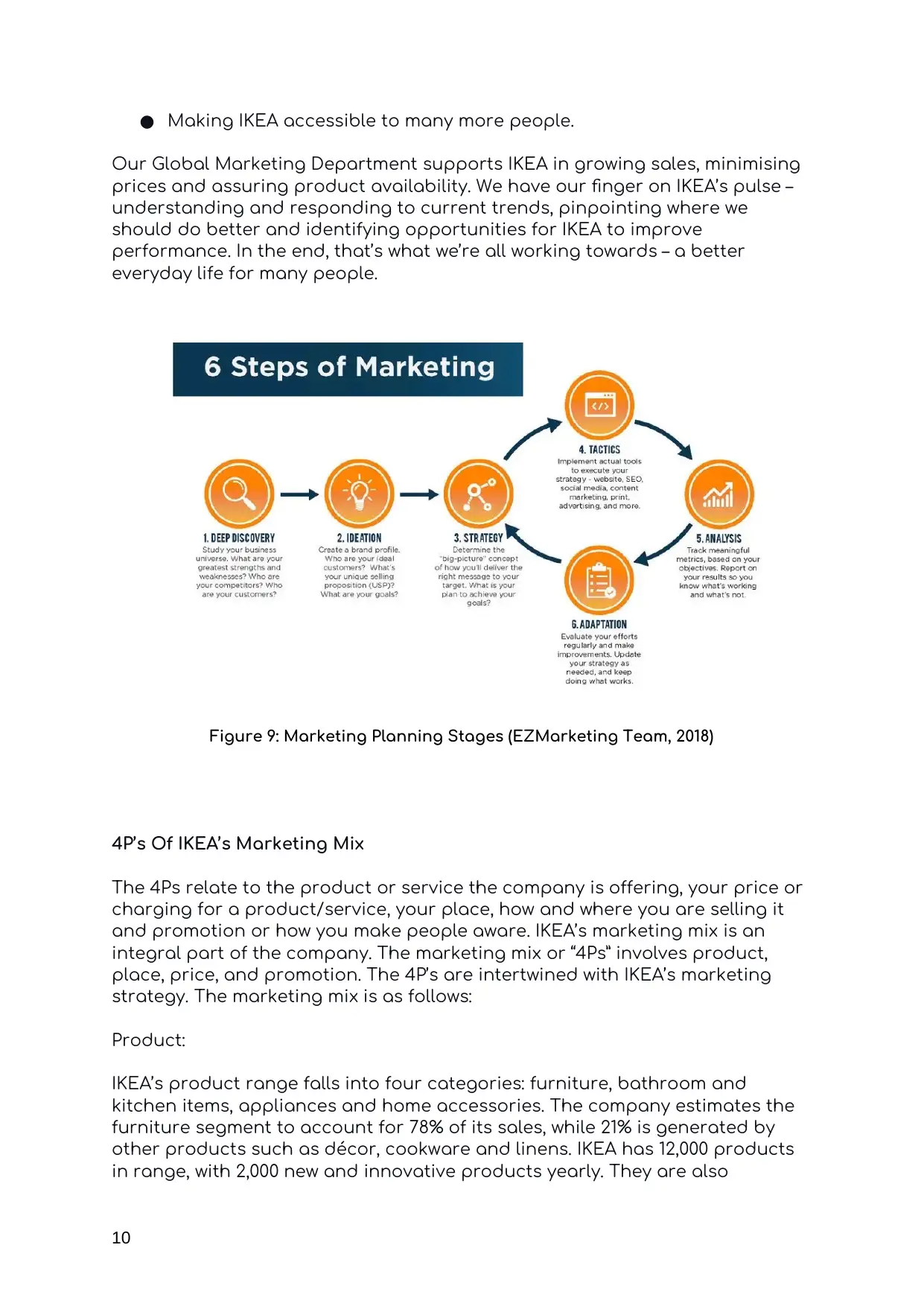
● Making IKEA accessible to many more people.
Our Global Marketing Department supports IKEA in growing sales, minimising
prices and assuring product availability. We have our finger on IKEA’s pulse –
understanding and responding to current trends, pinpointing where we
should do better and identifying opportunities for IKEA to improve
performance. In the end, that’s what we’re all working towards – a better
everyday life for many people.
Figure 9: Marketing Planning Stages (EZMarketing Team, 2018)
4P’s Of IKEA’s Marketing Mix
The 4Ps relate to the product or service the company is offering, your price or
charging for a product/service, your place, how and where you are selling it
and promotion or how you make people aware. IKEA’s marketing mix is an
integral part of the company. The marketing mix or “4Ps” involves product,
place, price, and promotion. The 4P’s are intertwined with IKEA’s marketing
strategy. The marketing mix is as follows:
Product:
IKEA’s product range falls into four categories: furniture, bathroom and
kitchen items, appliances and home accessories. The company estimates the
furniture segment to account for 78% of its sales, while 21% is generated by
other products such as décor, cookware and linens. IKEA has 12,000 products
in range, with 2,000 new and innovative products yearly. They are also
10
Our Global Marketing Department supports IKEA in growing sales, minimising
prices and assuring product availability. We have our finger on IKEA’s pulse –
understanding and responding to current trends, pinpointing where we
should do better and identifying opportunities for IKEA to improve
performance. In the end, that’s what we’re all working towards – a better
everyday life for many people.
Figure 9: Marketing Planning Stages (EZMarketing Team, 2018)
4P’s Of IKEA’s Marketing Mix
The 4Ps relate to the product or service the company is offering, your price or
charging for a product/service, your place, how and where you are selling it
and promotion or how you make people aware. IKEA’s marketing mix is an
integral part of the company. The marketing mix or “4Ps” involves product,
place, price, and promotion. The 4P’s are intertwined with IKEA’s marketing
strategy. The marketing mix is as follows:
Product:
IKEA’s product range falls into four categories: furniture, bathroom and
kitchen items, appliances and home accessories. The company estimates the
furniture segment to account for 78% of its sales, while 21% is generated by
other products such as décor, cookware and linens. IKEA has 12,000 products
in range, with 2,000 new and innovative products yearly. They are also
10
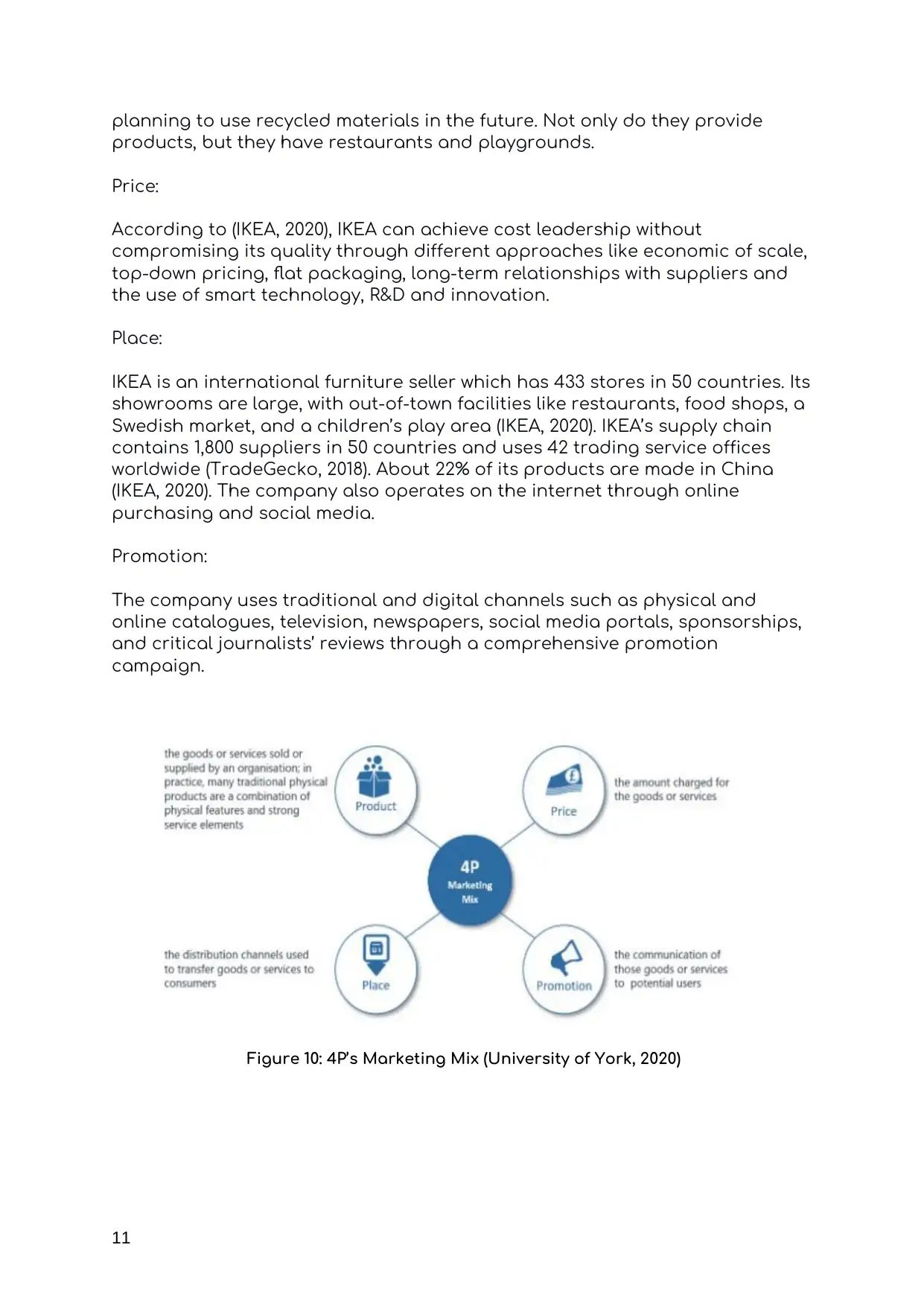
planning to use recycled materials in the future. Not only do they provide
products, but they have restaurants and playgrounds.
Price:
According to (IKEA, 2020), IKEA can achieve cost leadership without
compromising its quality through different approaches like economic of scale,
top-down pricing, flat packaging, long-term relationships with suppliers and
the use of smart technology, R&D and innovation.
Place:
IKEA is an international furniture seller which has 433 stores in 50 countries. Its
showrooms are large, with out-of-town facilities like restaurants, food shops, a
Swedish market, and a children’s play area (IKEA, 2020). IKEA’s supply chain
contains 1,800 suppliers in 50 countries and uses 42 trading service offices
worldwide (TradeGecko, 2018). About 22% of its products are made in China
(IKEA, 2020). The company also operates on the internet through online
purchasing and social media.
Promotion:
The company uses traditional and digital channels such as physical and
online catalogues, television, newspapers, social media portals, sponsorships,
and critical journalists’ reviews through a comprehensive promotion
campaign.
Figure 10: 4P’s Marketing Mix (University of York, 2020)
11
products, but they have restaurants and playgrounds.
Price:
According to (IKEA, 2020), IKEA can achieve cost leadership without
compromising its quality through different approaches like economic of scale,
top-down pricing, flat packaging, long-term relationships with suppliers and
the use of smart technology, R&D and innovation.
Place:
IKEA is an international furniture seller which has 433 stores in 50 countries. Its
showrooms are large, with out-of-town facilities like restaurants, food shops, a
Swedish market, and a children’s play area (IKEA, 2020). IKEA’s supply chain
contains 1,800 suppliers in 50 countries and uses 42 trading service offices
worldwide (TradeGecko, 2018). About 22% of its products are made in China
(IKEA, 2020). The company also operates on the internet through online
purchasing and social media.
Promotion:
The company uses traditional and digital channels such as physical and
online catalogues, television, newspapers, social media portals, sponsorships,
and critical journalists’ reviews through a comprehensive promotion
campaign.
Figure 10: 4P’s Marketing Mix (University of York, 2020)
11
⊘ This is a preview!⊘
Do you want full access?
Subscribe today to unlock all pages.

Trusted by 1+ million students worldwide
1 out of 19
Related Documents
Your All-in-One AI-Powered Toolkit for Academic Success.
+13062052269
info@desklib.com
Available 24*7 on WhatsApp / Email
![[object Object]](/_next/static/media/star-bottom.7253800d.svg)
Unlock your academic potential
Copyright © 2020–2025 A2Z Services. All Rights Reserved. Developed and managed by ZUCOL.





